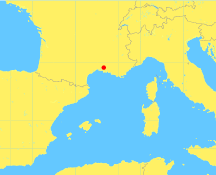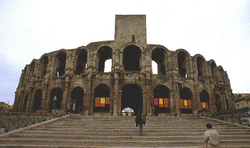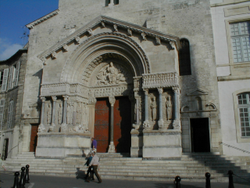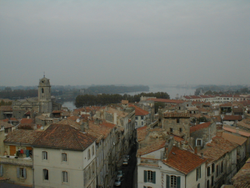Arles
|
|

Arles (Arle in Provençal) is a city in the south of France, in the Bouches-du-Rhône département, of which it is a sous-préfecture, in the former province of Provence.
| Contents |
Geography
The Rhône river divides itself in two arms in Arles, forming the Camargue delta. Because the Camargue is administratively part of Arles, the latter is the largest commune in France in terms of territory, although its population is only slightly more than 50,000. Its area is 759 km², which is seven times the area of Paris.
History
Roman Arles
Arles is an ancient town, having been established by the Greeks as early as the 6th century BC under the name of Theline. It was captured by the Celtic Saluvii in 535 BC, who renamed it to Arelate. The Romans took the town in 123 BC and expanded it into an important city, with a canal link to the Mediterranean Sea being constructed in 104 BC. However, it struggled to escape the shadow of Massalia (Marseille) further along the coast.
Its chance came in 40 BC, when it sided with Julius Caesar against Pompey, providing military support. Massalia made the mistake of backing Pompey; when Caesar emerged victorious, Massalia was stripped of its possessions, which were transferred to Arelate as a reward. The town was formally established as a colony for veterans of the Roman legion Legio VI Ferrata, which had its base there. Its full title as a colony was Colonia Iulia Paterna Arelatensium Sextanorum, "the ancestral Julian colony of Arles of the soldiers of the Sixth."
Arles_Roman_amphitheatre_pillar_ruins.jpg
Roman Arelate was a city of considerable importance in the province of Gallia Narbonensis. It covered an area of some 99 acres (400,000 m²) and possessed an impressive array of monuments, including an amphitheater, triumphal arch, circus, theatre and a full circuit of walls. It was closer to the sea than it is now and served as a major port. It also had (and still does have) the southernmost bridge on the Rhône. Very unusually, the Roman bridge was not fixed but used a pontoon-style bridge of boats, with towers and drawbridges at each end. The boats were secured in place with anchors and by being tethered to twin towers built just upstream of the bridge. This unusual design was a way of coping with the river's frequent violent floods, which would have made short work of a conventional bridge. Nothing now remains of the Roman bridge, which has been replaced by a more modern bridge near the same spot.
The city reached its peak during the 4th and 5th centuries, when it was frequently used as headquarters for Roman Emperors during military campaigns. In 395 it became the seat of the Praetorian Prefecture of the Gaul, governing an area that included Gaul proper plus Hispania (Spain) and Armorica (Brittany).
It became a favorite city of Emperor Constantine the Great, who built baths there, substantial remains of which are still standing. His son, Constantine II was born there. Emperor Constantine III declared himself emperor in the West (407-411) and made Arles his capital in 408.
Arles became renowned as a cultural and religious centre during the late Roman Empire. It was the birthplace of the skeptical philosopher Favorinus. It was also a key location for Roman Christianity and an important base for the Christianization of Gaul. The city's bishopric was held by a series of outstanding clerics, beginning with Saint Trophimus around 225 and continuing with Saint Honoré, then Saint Hilary in the first half of the 5th century. The political tension between the catholic bishops of Arles and the Visigothic kings is epitomized in the career of the Frankish St Caesarius, bishop of Arles 503 – 542, who was suspected by the Arian Visigoth Alaric II of conspiring with the Burgundians to turn over the Arelate to Burgundy, and was exiled for a year to Bordeaux in Aquitaine, and again in 512 when Arles held out against Theodoric Caesarius was imprisoned and sent to Ravenna to explain his actions before the Ostrogoth Wace, Dictionary (http://www.ccel.org/w/wace/biodict/htm/iii.iii.iv.htm)).
The friction between the Arian Christianity of the Visigoths and the more orthodox Catholicism of the bishops sent out from Rome established deep roots for religious heterodoxy, even heresy, in Occitan culture. At Treves in 385, Priscillian achieved the distinction of becoming the first Christian burned alive for heresy (Manichaean in his case, see also Cathars, Camisards).
Despite this tension and the city's decline in the face of barbarian invasions, Arles remained a great religious centre, the rival of Vienne, for hundreds of years. In all, 19 synods were held there. One of the most significant Arlesian synods was that of 314, at which the heresy of Donatism was formally condemned. Other notable synods were those of 353, called in support of Arianism; 1234, which opposed the Albigensian heresy; and 1263, which condemned the doctrines of Joachim of Fiore, a 12th century monk and mystic.
Medieval Arles
Sttrophimecloister.png
Arles was badly affected by the invasion of Provence by the Muslim Saracens and the Franks, who took control of the region in the 6th century. In 855 it was made the capital of a Frankish Kingdom of Arles, which included Burgundy and part of Provence, but was frequently terrorised by Saracen and Viking raiders. In 888, Rodolphe, Count of Auxerre (now in north-western Burgundy) founded the kingdom of Bourgogne Transjurane (literally, beyond the Jura mountains), which included western Switzerland as far as the river Reuss, Valais, Geneva, Chablais and Bugey. In 933, Hugh of Arles ("Hugues de Provence") gave his kingdom up to Rodolphe II, who merged the two kingdoms into a new Kingdom of Arles. In 1033, King Rodolphe III bequeathed the Kingdom to Emperor Conrad II the Salic. Though his successors counted themselves kings of Arles, few went to be crowned in the cathedral. Most of the territory of the Kingdom was progressively incorporated to France. During these troubled times, the ampitheatre was converted into a fortress, with watchtowers built at each of the four quadrants and a minuscule walled town being constructed within. The population was by now only a fraction of what it had been in Roman times, with much of old Arles lying in ruins.
The town regained political and economic prominence in the 12th century, with the Holy Roman Emperor Frederick Barbarossa traveling there in 1178 for his coronation. In the 12th century, it became a free city governed by an elected podestat (literally "power"), who appointed the consuls and other magistrates. It retained this status until the French Revolution of 1789.
Arles joined the county of Provence in 1239 but suffered its prominence being eclipsed once more by Marseille. In 1378, the Holy Roman Emperor Charles IV ceded the remnants of the Kingdom of Arles to the Dauphin of France (later King Charles VI of France) and the Kingdom ceased to exist even on paper.
Arles-PlaceDuForum.jpg
Gogh4.jpg
Modern Arles
Arles remained economically important for many years as a major port on the Rhône. The arrival of the railway in the 19th century eventually killed off much of the river trade, leading to the town becoming something of a backwater.
This made it an attractive destination for the painter Vincent van Gogh, who arrived there on 21 February 1888. He was fascinated by the Provençal landscapes, producing over 300 paintings and drawings during his time in Arles. Many of his most famous paintings were completed there, including the Night Cafe, the Yellow Room, Starry Night, and L'Arlesienne. Paul Gauguin visited van Gogh in Arles. However, van Gogh's mental health deteriorated and he became alarmingly eccentric, culminating in the infamous ear-severing incident in December 1888. The concerned Arlesians circulated a petition the following February demanding that van Gogh be confined. In May 1889 he took the hint and left Arles for the asylum at nearby St-Rémy-de-Provence.
The Provençal poet Frédéric Mistral was born near Arles.
Sights
Important remains of Roman times include the ancient theater, the arena or amphitheater, and the Alyscamps (Roman necropolis). They have been listed as World Heritage Sites since 1981.
The Church of St. Trophime (Saint Trophimus), formerly a cathedral, is a major work of Romanesque architecture, and the representation of the Last Judgment on its portal is considered one of the finest examples of Romanesque sculpture, as are the columns in the adjacent cloister.
The town also has an outstanding museum of ancient history, with one of the best collections of Roman sarcophagi to be found anywhere outside Rome itself. However, perhaps surprisingly given the town's importance to van Gogh, none of his works are on display in Arles.
Miscellaneous
A famous photography festival takes place in Arles every year, and the French national school of photography is located there. The major French publishing house Actes Sud is also situated in Arles.
Bull fights are conducted in the Roman amphitheater, including Provencal-style bullfights (courses camarguaises) in which the bull is not killed but rather a team of athletic men attempt to remove a tassle from the bull's horn without getting injured. Every Easter, Arles also holds a Spanish-style corrida (in which the bull is killed) with an encierro (bull-running in the streets) preceding each fight.
Jeanne Calment (1875-1997), the oldest human being whose age is documented, was born, lived and died in Arles.
Current French international football star Djibril Cissé was born in Arles.
External link
- Early history: http://www.ancientroute.com/cities/arles.htmbg:Арл
da:Arles de:Arles fr:Arles gl:Arles it:Arles la:Arelate nl:Arles ru:Арль sv:Arles




